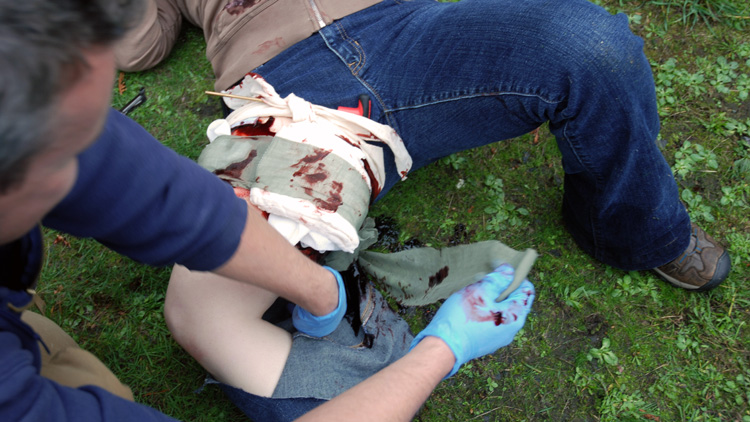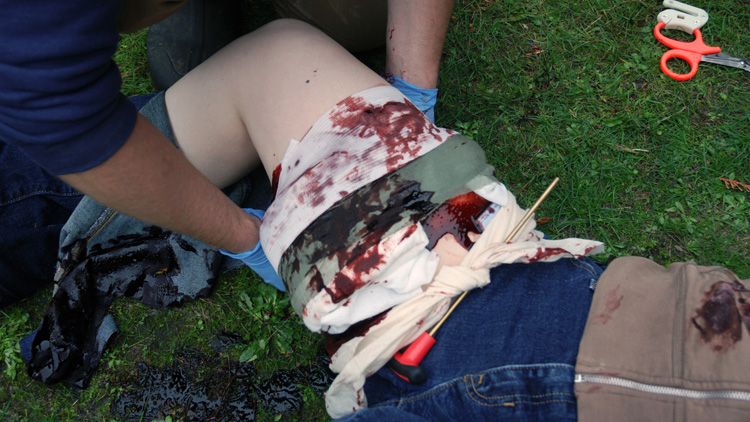
It's no secret that firearms can be dangerous. Unfortunately, NDs and ADs do happen, and, just like in any other sport, people can, and do, get hurt while shooting and hunting. Whether or not somebody has the knowledge and skills of firearms first aid to help an injured person could, quite literally, be the difference between life and death. Luckily many organizations around the world, similar to Mississauga C2C First Aid Aquatics, offer first aid and CPR training to those who are interested in learning this valuable and life-saving skill. Since there is a lot that goes into first aid when it comes to firearms, we want to try our best to ensure that you are equipped with the knowledge should you find yourself in a similar situation. As well as the useful information in this article, you can also use this website to get yourself a fully equipped first aid kit box, filled with all of the necessary medical supplies to help you handle any situations that may unfold.
This article will demonstrate some basic first aid skills pertaining to common injuries from gunshots, but it is in no way a substitute for proper, hands-on training from a qualified individual. And because of that, we at Calibre, cannot accept any responsibility for the outcomes of the application of these techniques. We strongly recommend that everyone, particularly those who spend a lot of time outdoors with dangerous tools, attend a quality training course. It is, in our opinion, the responsible thing to do.
Before dealing with any first aid situation, you must make sure the scene is safe for you to approach. You must then identify yourself to the patient and obtain their consent to help (in Canada, if a patient is unconscious, you have their implied consent). It's also important to make sure that 911 has been called and help is on the way.
Here are a couple of scenarios where you might need some knowledge of firearms first aid; out in the wild, and on the range:
Firearms First Aid - Out Hunting
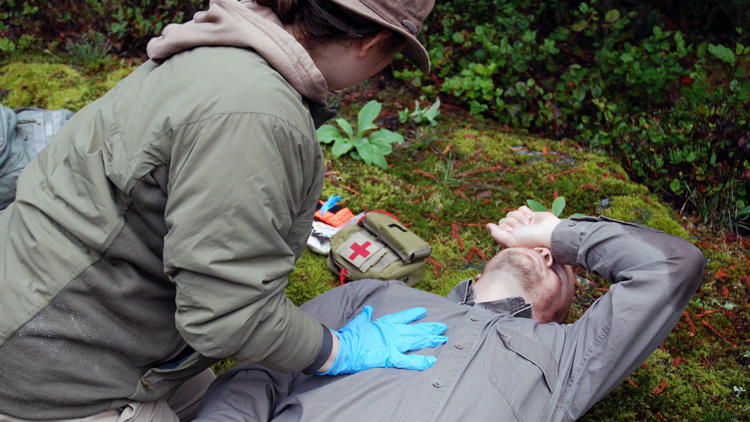
You?ve been stalking a good size Muley for most of the morning, when his trail leads you out of the bush onto the edge of a cut-block. The crack of the rifle report hits your ears at the same time 150 grains of boat-tailed lead and copper blasts through your friend?s chest. He gets spun around and hits the ground.
Not knowing any better, the shooter had fired an FMJ; not good for deer, but a small saving grace for your pal. The bullet entered the far right-hand edge of the chest and went clean through, and out the other side.
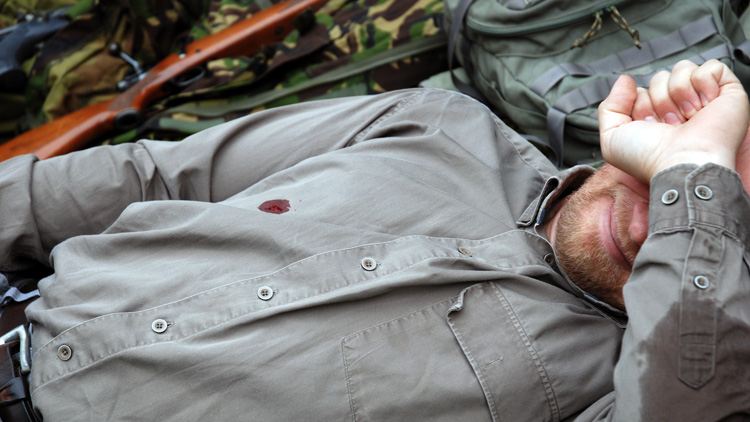
Assuming that you have already yelled out to the shooter, alerting them to your presence and screaming for them to get help, it is now time for you to get to work:
Hopefully you?ve packed a first aid kit in an easily accessible place. After slipping on your nitrile gloves (these are important to protect both you and your buddy from infection), you grab your shears, cut away his backpack straps and move his gear to clear some space. Next you cut open his clothing and expose the chest. If you don?t have shears in your kit, you can use a knife, but be extra careful that you don?t add stabbing to his list of injuries! If the wound was more than a few minutes old, blood could start to dry and act as a glue sticking clothing to the wound. In this case, you wouldn?t rip the clothing off; you would cut away the material around the stuck portion and then dress the wound over the top of the remaining material.
Often, with this type of chest injury, you?ll hear a sucking noise coming from the holes; this likely indicates a tension pneumothorax. Air pressure from the outside world is flowing into the chest cavity. Contrary to what might be believed, this air is not entering the lungs, in fact it is squashing the lungs causing them to collapse and prevent normal breathing. Time to act fast.
Firmly place one gloved hand over the wound to seal it; keep the other hand free to work. If he?s able, tell your pal to do this with his own hand. Next you roll him over and check the exit wound; it?s a slightly larger hole, so you?ll start there.
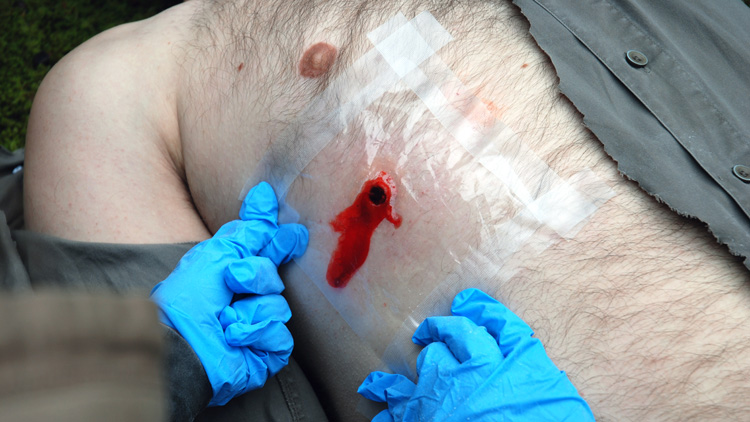
Apply the plastic dressing to the wound when the casualty exhales. If you have tape, secure the dressing to the wound by taping it on three sides; duct tape is great for this. Make sure to leave the side on the outside of the chest untaped; this opening allows air to escape the chest cavity, but not go in - a rudimentary one-way flutter valve. It is very important to make sure that the unsealed edge is on the outer side of the chest for reasons that you?ll see later.
Now you?ll do the same thing with the smaller, entry wound. Once both holes have occlusive dressings taped in place, you can secure them further by applying a standard field dressing, or improvised padding and bandage, over the top, and tying it securely. Make sure to tie your knot when the casualty exhales, but don?t tie it so tightly that it restricts his breathing.
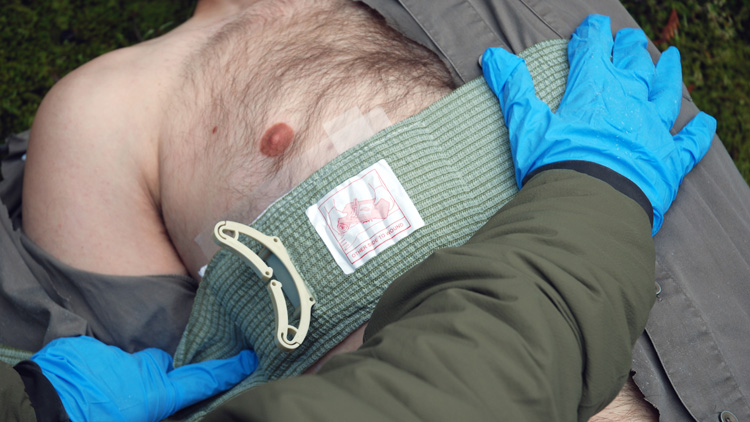
I?m sure many of you have seen movies where the medic then sticks the hero?s chest with a heavy gauge decompression needle, and then he takes a deep breath of relief. And whilst Hollywood makes it look simple enough, do not attempt it unless you have been properly trained. There is a high risk of doing more harm than good if done incorrectly.
Now roll your buddy onto his injured side and place him in the recovery position. This allows blood and other fluids to drain out of the unsealed side of the occlusive dressing, and not collect inside. It may not be comfortable for the casualty, but too bad; it?s the best position for him.
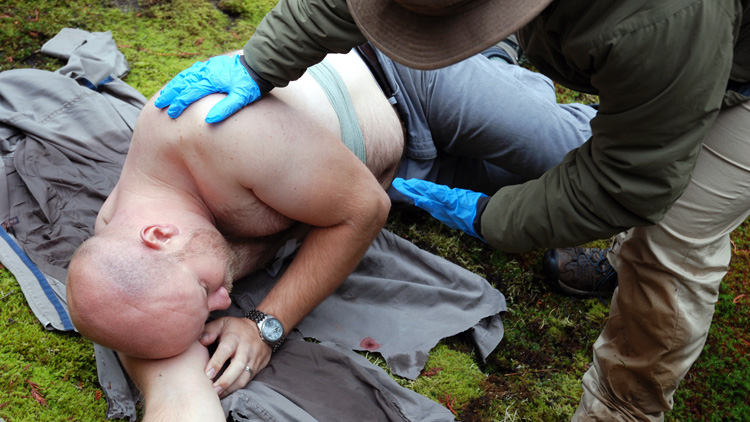
This is all you can do from a first aid perspective; this life threatening injury needs advanced medical care as soon as possible.
Firearms First Aid - On The Range
You?re getting ready to practice on your local range, when you hear a bang and a scream from the next bay. A shooter has taken a round to the thigh.
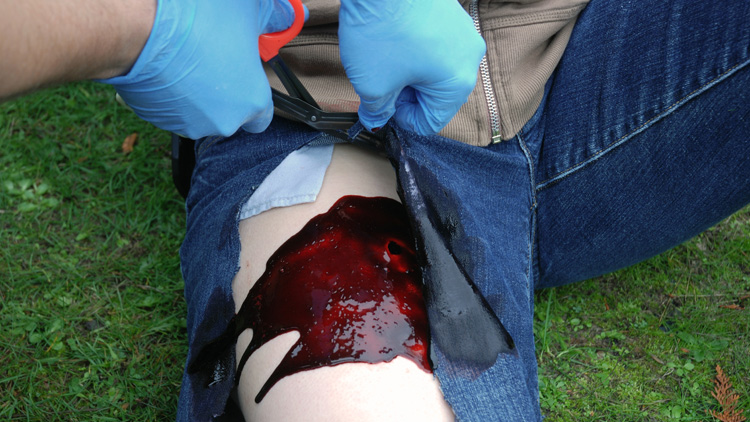
Blood gushes out of the entry hole in violent spurts. The femoral artery has been hit. Unless you can stop the bleeding, this girl has probably only got a couple of minutes to live. First step is to apply firm, direct pressure to the wound. Enlist the help of other people if they?re available. Make sure everyone has nitrile gloves on to protect themselves. If your direct pressure is not enough to stop the bleeding, then you may need to apply an emergency tourniquet.
If your kit has a purpose built tourniquet such as, my favourite, the CAT (Combat Application Tourniquet), then applying it and cranking down the pressure is fairly easy. If you don?t have a CAT, you can improvise an effective tourniquet by taking any strong piece of cloth or cord, like a folded triangular bandage and tying it firmly around the limb well above the injury. Tie a simple overhand knot and then place something onto to act as a windlass; a section from a cleaning rod works well. Next tie another overhand knot on top of the windlass and turn it to tighten the tourniquet. Keep turning and tightening until the worst of the bleeding stops. Note that this will not be a pleasant experience for the casualty! Secure the windlass in place with another piece of cloth, cord, or tape.
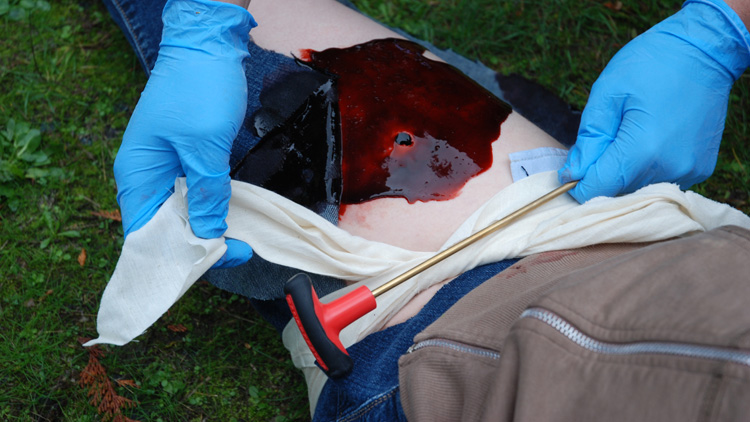
Now you?ve slowed the worst of the bleeding, you can deal with the wounds themselves.
Starting with the largest hole - the exit wound - first, pack the wound with sterile gauze; if you don?t have gauze, any clean material will be better than nothing. Once packed, place a large dressing over the top and bandage it securely in place. Make sure that the bandage completely covers the dressing to keep out any dirt.
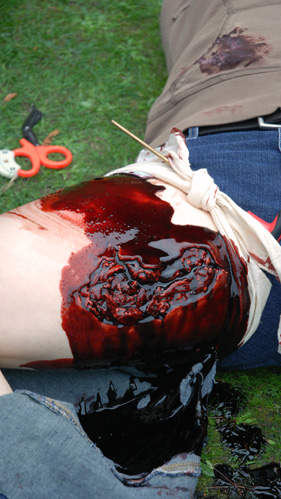
This process will hopefully stymie the blood loss long enough for the casualty to get to hospital.
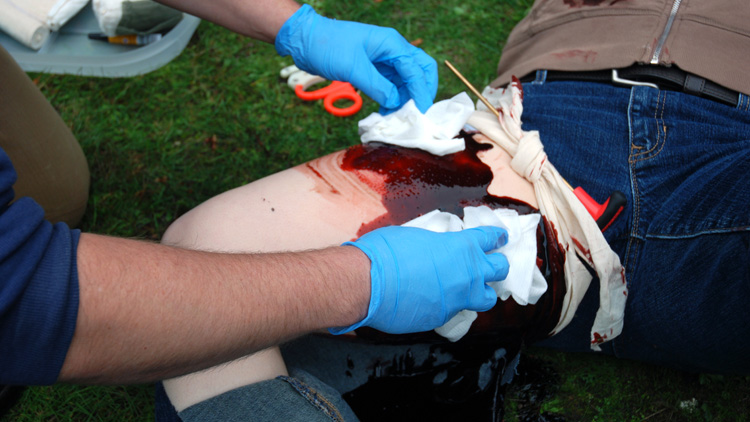
Place one hand on top of the other, in the middle of the patient?s chest. Lock your arms straight, and position your torso directly over theirs. Keeping your arms straight, allow your body weight to press down firmly on the patient?s chest approximately 2? deep. Then lift your body back up, and then repeat the process at 100 presses per minute (time it to the beat of ?Stayin? Alive? by the Bee Gees).
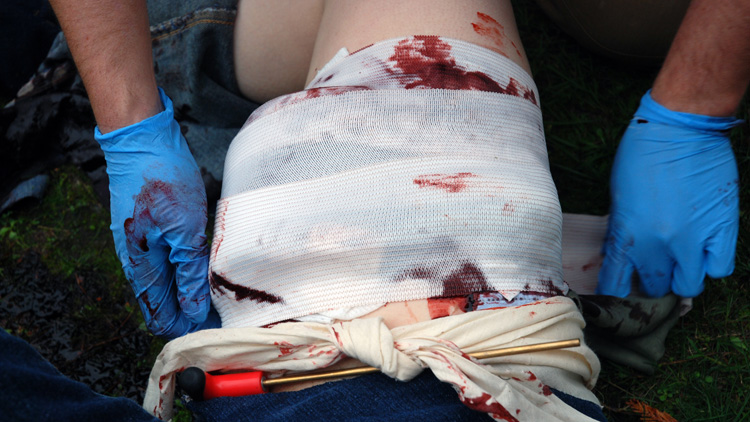
First aid really isn?t that complicated, but it is an essential, yet often overlooked, skill. Hopefully, this was either a great refresher, or, it has inspired you to go out and get some training; after all, one day it might be you who needs the help, and you?ll be glad to have a trained first aider near by.
